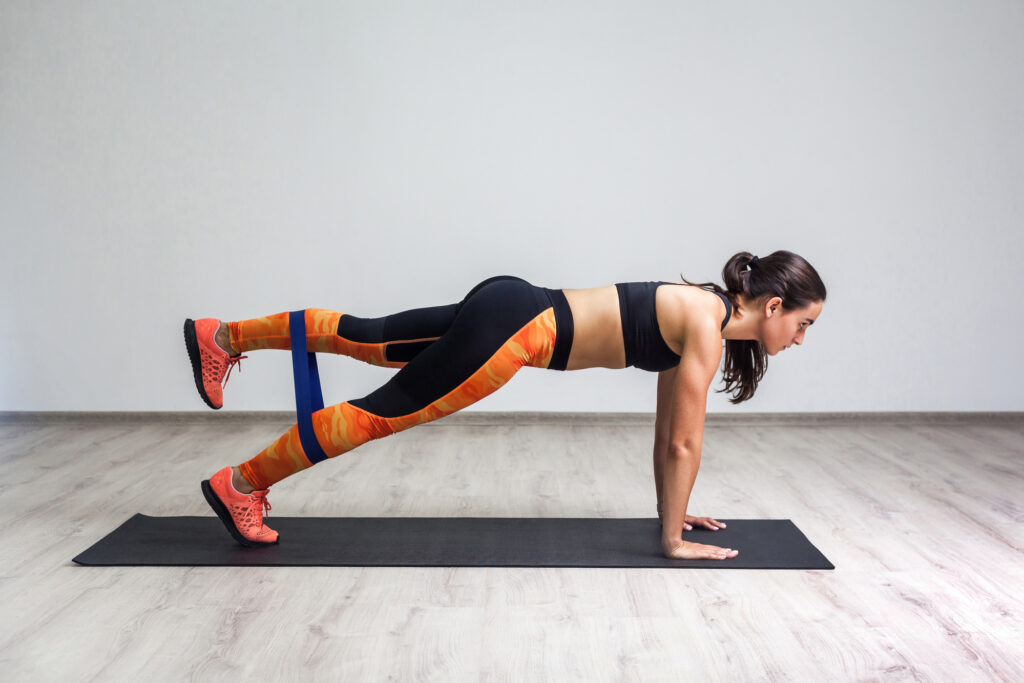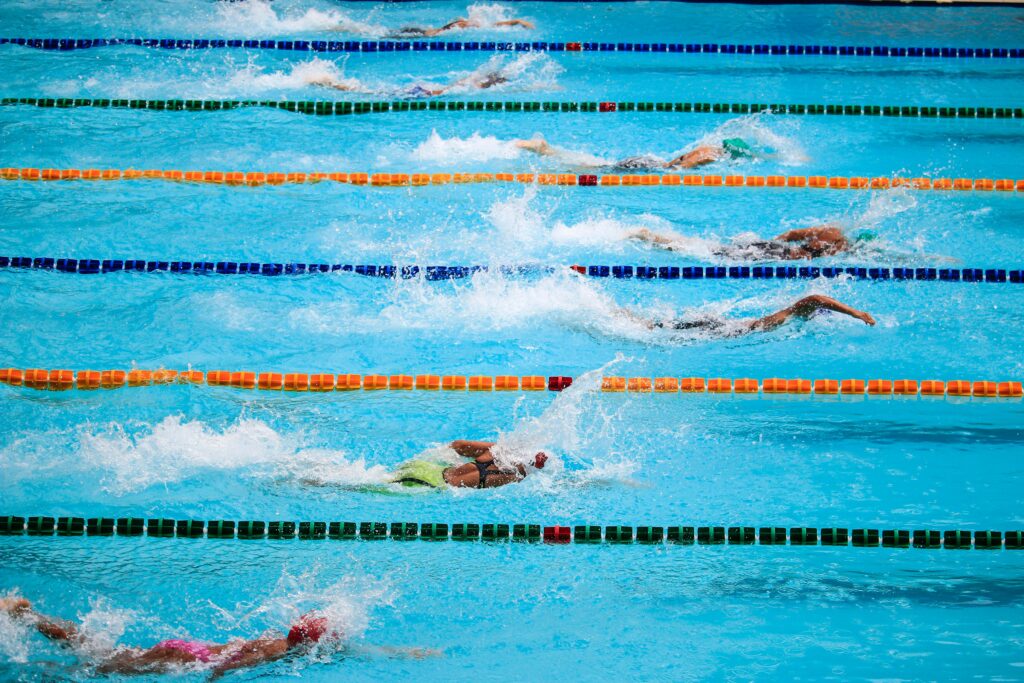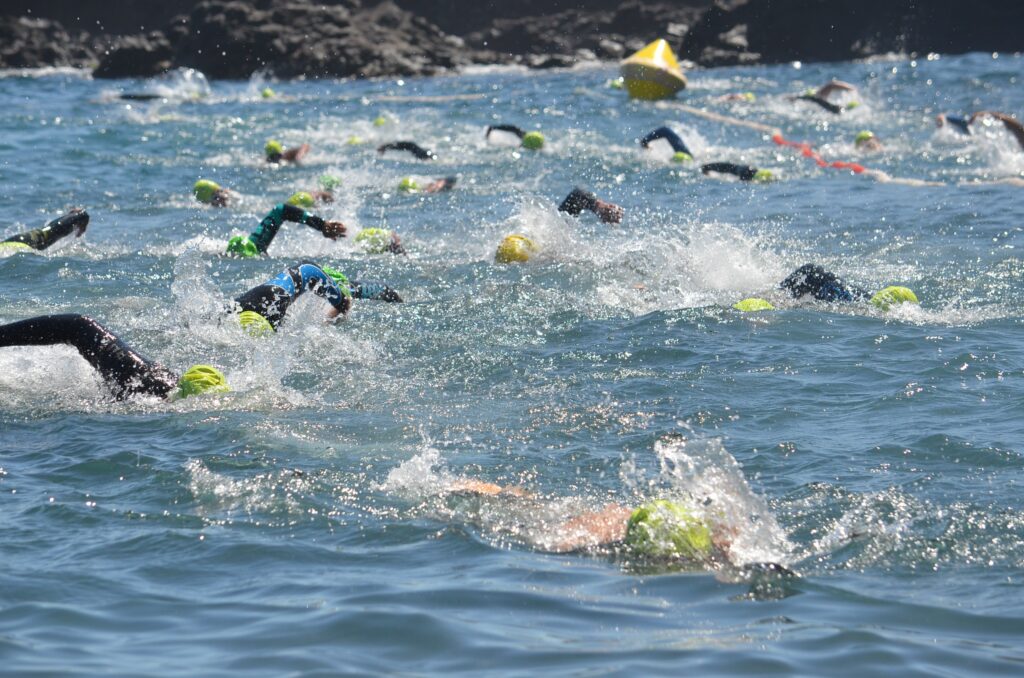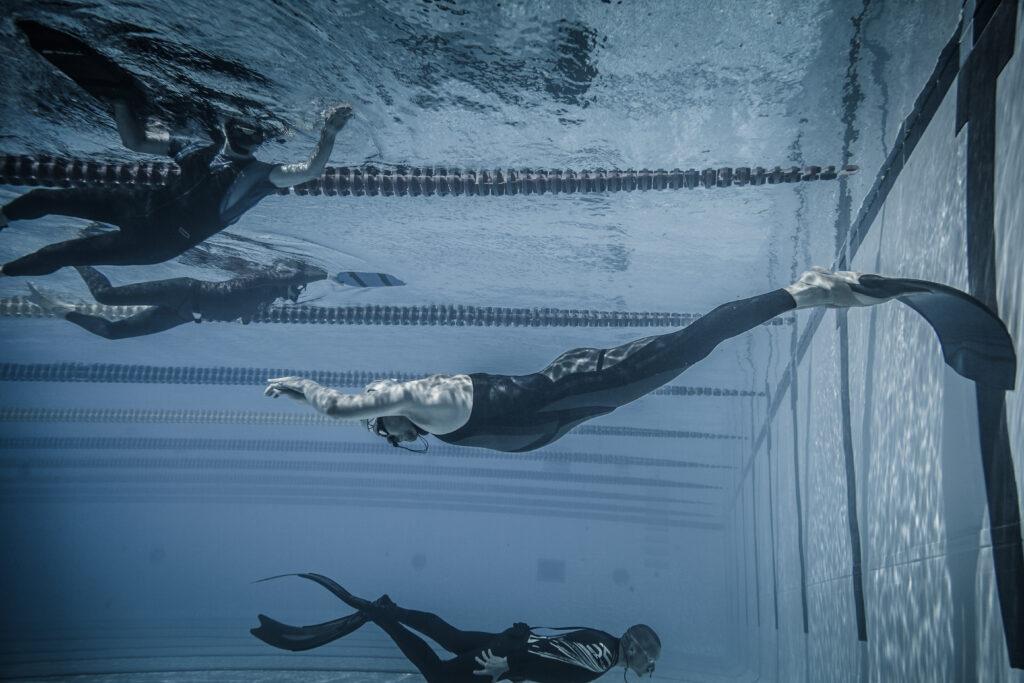Resistance bands are a versatile and effective tool for improving strength, flexibility, and swimming stroke. They are large elastic bands that can be used to target all areas of the body, making them a great option for people with limited mobility, as many of the exercises can be done while seated.
Resistance bands work by providing resistance as you stretch them, which engages your muscles and makes them work harder. This resistance can be adjusted by using bands with different levels of tension, allowing you to gradually increase the intensity of your workout as you get stronger. By incorporating resistance bands into your exercise routine, you can improve your muscle strength and endurance, as well as your flexibility and range of motion.
Using resistance bands can also be beneficial for swimmers looking to optimize their stroke. By targeting specific muscle groups used in swimming, such as the shoulders, back, and core, resistance band exercises can help swimmers build strength and power outside of the water, which can translate to improved performance in the pool. However, it is important to use resistance bands safely and with proper form to avoid injury.
Key Takeaways
- Resistance bands are a versatile tool that can be used to improve strength, flexibility, and swimming stroke.
- Resistance bands work by providing resistance as you stretch them, which engages your muscles and makes them work harder.
- Incorporating resistance band exercises into your workout routine can help you build strength and power, as well as improve your flexibility and range of motion.

Understanding Resistance Bands
Resistance bands are elastic bands that come in different lengths, thicknesses, and resistance levels. They are a versatile and affordable tool that can help improve strength, flexibility, and overall fitness. In this section, we will explain how resistance bands work and how they can be used to enhance your swimming stroke.
How do resistance bands work?
Resistance bands work by providing external resistance to your muscles as you perform different exercises. The resistance they provide can range from light to heavy, depending on the band’s thickness and length. By adding resistance, your muscles have to work harder to overcome it, which can lead to increased strength and endurance.
Resistance bands can also help improve flexibility by providing a gentle stretch to your muscles as you perform different exercises. This stretch can help increase your range of motion, which is essential for proper swimming stroke mechanics.
How can resistance bands improve your swimming stroke?
Resistance bands can be used to target specific muscle groups used in swimming, such as the shoulders, back, and core. By performing exercises that mimic swimming movements, you can strengthen these muscles, which can lead to improved stroke mechanics and increased speed in the water.
Here are some examples of resistance band exercises that can help improve your swimming stroke:
- Shoulder external rotation: Attach a resistance band to a stable object at waist height. Stand with your side facing the anchor point, and hold the band with your arm bent at a 90-degree angle. Slowly rotate your arm away from your body, keeping your elbow close to your side. Repeat for several repetitions before switching sides.
- Lat pulldown: Attach a resistance band to a stable object above your head. Hold the band with both hands, and sit with your back straight and feet flat on the ground. Pull the band down towards your chest, squeezing your shoulder blades together. Slowly release back to the starting position and repeat for several repetitions.
- Core rotation: Attach a resistance band to a stable object at waist height. Stand with your side facing the anchor point, and hold the band with both hands. Rotate your torso away from the anchor point, keeping your arms straight. Slowly return to the starting position and repeat for several repetitions before switching sides.
By incorporating resistance band exercises into your training routine, you can improve your strength, flexibility, and overall swimming performance.

Mechanism of Resistance Bands
Resistance bands work by creating tension in the muscles, which helps to improve strength and flexibility. They are made of elastic material, which stretches when pulled. As the band stretches, it creates resistance, which the body must work against to perform the exercise. This resistance helps to build strength and muscle tone.
Resistance bands are particularly effective for swimming stroke improvement because they allow for a wider range of motion than traditional weights. This means that swimmers can perform exercises that mimic the movements of swimming strokes, which can help to improve technique and power in the water.
When using resistance bands for swimming stroke improvement, it’s important to choose the right level of resistance. Too much resistance can cause injury, while too little resistance won’t provide enough of a challenge. It’s also important to use proper form and technique when performing exercises with resistance bands to ensure maximum effectiveness and safety.
Overall, resistance bands are an effective tool for improving strength, flexibility, and swimming stroke. By creating tension in the muscles and allowing for a wider range of motion, they can help swimmers to build strength and improve technique in the water.
Improving Strength with Resistance Bands
Resistance bands are a versatile and effective tool for improving strength. They work by providing resistance to the muscles, forcing them to work harder and become stronger. Here are some ways that resistance bands can help improve your strength:
Target Specific Muscle Groups
Resistance bands can be used to target specific muscle groups, such as the biceps, triceps, chest, back, and legs. By using different types of bands and varying the resistance level, you can create a customised workout that targets the areas you want to improve.
Increase Resistance Over Time
Resistance bands are also great for progressive overload, which is the process of gradually increasing resistance over time to continue challenging the muscles and promoting strength gains. As you get stronger, you can increase the resistance level of the bands, making your workouts more challenging and effective.
Improve Swim Stroke
Resistance bands can also be used to improve swimming stroke. By attaching a band to a stationary object and holding onto the other end, you can simulate the resistance of water and work on your swimming technique. This can help improve your strength and endurance in the water.
Use Anywhere, Anytime
One of the biggest benefits of resistance bands is their portability. They are lightweight and easy to pack, making them an ideal tool for working out at home, on the go, or while travelling. You can even use them while watching TV or sitting at your desk.
Overall, resistance bands are a cost-effective and convenient way to improve strength and flexibility. By incorporating them into your workouts, you can target specific muscle groups, increase resistance over time, and even improve your swimming stroke.

Enhancing Flexibility Using Resistance Bands
Resistance bands are a versatile tool that can help improve flexibility in swimmers. Incorporating resistance band exercises into your swimming training can help to increase range of motion, improve joint mobility, and reduce the risk of injury.
One of the main benefits of using resistance bands for flexibility training is that they allow you to stretch and strengthen muscles at the same time. By providing resistance throughout the entire range of motion, resistance bands can help to activate and strengthen the muscles being stretched.
To use resistance bands for flexibility training, start by selecting a band with the appropriate resistance level for your current fitness level. Then, choose exercises that target the specific muscles you want to stretch. Some examples of resistance band stretches for swimmers include:
- Shoulder Stretch: Place the resistance band behind your back and hold onto each end with your hands. Slowly raise your arms up behind you, stretching the band as you go. Hold for a few seconds, then release and repeat.
- Hip Stretch: Place the resistance band around your ankles and stand with your feet hip-width apart. Step to the side with one foot, stretching the band as you go. Hold for a few seconds, then return to the starting position and repeat on the other side.
- Hamstring Stretch: Sit on the floor with your legs straight out in front of you and the resistance band looped around your feet. Hold onto the ends of the band and slowly lean forward, stretching the band as you go. Hold for a few seconds, then release and repeat.
When performing resistance band stretches, it’s important to use proper form and avoid overstretching. Start with a light resistance band and gradually increase the resistance as your flexibility improves.
Incorporating resistance band exercises into your swimming training can help to enhance your flexibility and improve your swimming stroke. By targeting specific muscle groups and providing resistance throughout the entire range of motion, resistance bands can help to increase range of motion, improve joint mobility, and reduce the risk of injury.
Optimising Swimming Stroke with Resistance Bands
Resistance bands are a versatile training tool that can be used to optimise your swimming stroke. By incorporating resistance band exercises into your swimming training, you can improve your strength, flexibility, and overall swimming performance.
One of the main benefits of resistance band exercises is that they can help you to develop the muscles used in your swimming stroke. For example, using a resistance band to perform exercises that mimic the movements of your freestyle stroke can help to strengthen the muscles in your shoulders, back, and arms. This can help you to generate more power and speed in the water, which can lead to faster swim times.
Resistance band exercises can also help to improve your flexibility, which is essential for developing a smooth and efficient swimming stroke. By performing exercises that stretch and strengthen the muscles used in your swimming stroke, you can improve your range of motion and reduce your risk of injury.
Another benefit of using resistance bands is that they can help you to develop your technique. By using a resistance band to perform exercises that focus on specific aspects of your swimming stroke, such as your catch or your pull, you can improve your technique and swim more efficiently.
When incorporating resistance band exercises into your swimming training, it’s important to choose exercises that are specific to your swimming stroke and that target the muscles used in that stroke. For example, if you are a freestyle swimmer, you may want to focus on exercises that target your shoulders, back, and arms. If you are a breaststroke swimmer, you may want to focus on exercises that target your chest and legs.
Overall, resistance bands can be a valuable tool for swimmers looking to improve their strength, flexibility, and swimming stroke. By incorporating resistance band exercises into your swimming training, you can develop the muscles used in your swimming stroke, improve your flexibility, and refine your technique, leading to faster swim times and a more efficient swimming stroke.

Safety Measures While Using Resistance Bands
When using resistance bands, safety should always be a top priority. Here are some measures to consider to ensure safe and effective use of resistance bands:
Choose the Right Band
Resistance bands come in different colours and levels of resistance. It’s essential to choose the right band that matches your fitness level and the exercise you intend to do. Using a band that is too strong can lead to muscle strain or injury, while using a band that is too weak will not provide enough resistance to challenge your muscles.
Inspect the Band
Before using a resistance band, inspect it for any signs of wear and tear. Look for any cuts, nicks, scratches, or punctures that could weaken the band. If you notice any flaws, discard the band immediately and replace it with a new one.
Use Proper Form
Using proper form when exercising with resistance bands is crucial to prevent injury and get the most out of your workout. Always maintain good posture and keep your core engaged. Avoid jerking the band or using momentum to perform the exercise. Instead, move slowly and with control, focusing on contracting the muscles you are targeting.
Secure the Band
When using a resistance band, make sure it is securely anchored to a stable object or your body. If you are attaching the band to a door or other object, ensure that the attachment point is secure and won’t come loose during the exercise. If you are using the band for a full-body workout, make sure it is securely wrapped around your body and won’t slip or come loose.
Start Slowly
If you are new to using resistance bands, start with a lower resistance band and work your way up gradually. This will help you avoid muscle strain and injury while allowing your body to adjust to the new form of exercise.
By following these safety measures, you can safely and effectively use resistance bands to improve your strength, flexibility, and swimming stroke.
Conclusion
In this article, we have explored how resistance bands can improve strength, flexibility, and swimming stroke. We have seen that resistance bands are a versatile and effective tool that can be used to target specific muscle groups and improve overall fitness.
Resistance bands work by providing variable resistance that increases as the band is stretched. This allows for a full range of motion and helps to build strength and flexibility. Resistance bands can be used to target specific muscle groups, such as the shoulders, back, and legs, which are important for swimming stroke.
In addition to building strength and flexibility, resistance bands can also improve swimming stroke technique. By using resistance bands to mimic the movements of swimming strokes, swimmers can improve their form and increase their power and speed in the water.
Overall, resistance bands are a valuable tool for swimmers looking to improve their strength, flexibility, and swimming stroke. By incorporating resistance band exercises into their training routine, swimmers can achieve better results and perform at their best in the water.
Frequently Asked Questions
What are the benefits of using resistance bands for swimming training?
Resistance bands are excellent tools for swimmers to improve their strength, flexibility, and overall swimming performance. They provide a low-impact workout that can help swimmers build muscle and increase their range of motion without putting undue stress on their joints.
How can resistance bands improve overall strength for swimmers?
Resistance bands are highly effective at building strength because they provide constant tension throughout the entire range of motion. This means that swimmers can work their muscles through a full range of motion, which can help to improve overall strength and power.
What are some effective exercises using resistance bands for swimming stroke improvement?
There are many effective exercises that swimmers can do using resistance bands to improve their swimming stroke. Some examples include resistance band pull-aparts, resistance band rows, and resistance band lat pulldowns. These exercises can help to strengthen the muscles used in swimming strokes and improve overall swimming technique.
How do resistance bands help with flexibility, which can enhance swimming performance?
Resistance bands are excellent tools for improving flexibility because they allow swimmers to stretch their muscles in a controlled and safe manner. By using resistance bands for stretching, swimmers can increase their flexibility and range of motion, which can help to enhance their swimming performance.
Are resistance bands a good tool for dry land swim training?
Yes, resistance bands are an excellent tool for dry land swim training. They provide a low-impact workout that can help to build strength and improve overall swimming performance. Additionally, they are highly portable and can be used anywhere, making them an ideal tool for swimmers who travel frequently.
What are the best types of resistance bands to use for swimming training?
The best types of resistance bands to use for swimming training are those that are specifically designed for strength training and flexibility. These bands are typically made from high-quality materials and are available in a variety of resistance levels, making them suitable for swimmers of all skill levels. It’s important to choose bands that are durable and easy to use, so that swimmers can get the most out of their training sessions.






